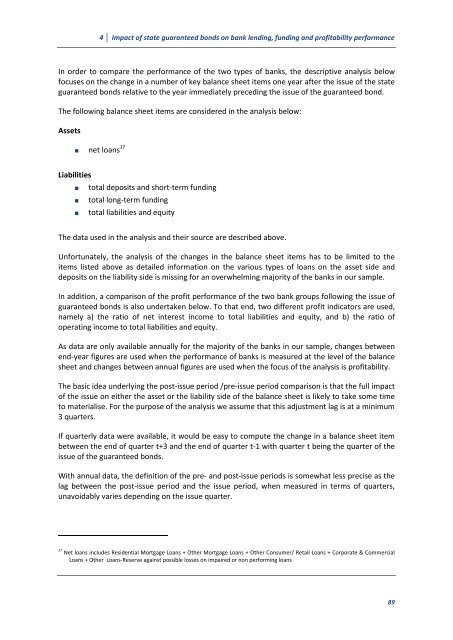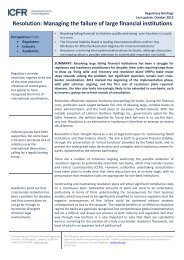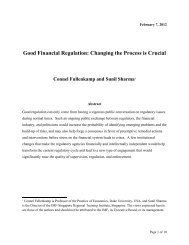3 Issuing costs of state guaranteed bonds - Financial Risk and ...
3 Issuing costs of state guaranteed bonds - Financial Risk and ...
3 Issuing costs of state guaranteed bonds - Financial Risk and ...
You also want an ePaper? Increase the reach of your titles
YUMPU automatically turns print PDFs into web optimized ePapers that Google loves.
4 Impact <strong>of</strong> <strong>state</strong> <strong>guaranteed</strong> <strong>bonds</strong> on bank lending, funding <strong>and</strong> pr<strong>of</strong>itability performance<br />
In order to compare the performance <strong>of</strong> the two types <strong>of</strong> banks, the descriptive analysis below<br />
focuses on the change in a number <strong>of</strong> key balance sheet items one year after the issue <strong>of</strong> the <strong>state</strong><br />
<strong>guaranteed</strong> <strong>bonds</strong> relative to the year immediately preceding the issue <strong>of</strong> the <strong>guaranteed</strong> bond.<br />
The following balance sheet items are considered in the analysis below:<br />
Assets<br />
net loans 17<br />
Liabilities<br />
total deposits <strong>and</strong> short-term funding<br />
total long-term funding<br />
total liabilities <strong>and</strong> equity<br />
The data used in the analysis <strong>and</strong> their source are described above.<br />
Unfortunately, the analysis <strong>of</strong> the changes in the balance sheet items has to be limited to the<br />
items listed above as detailed information on the various types <strong>of</strong> loans on the asset side <strong>and</strong><br />
deposits on the liability side is missing for an overwhelming majority <strong>of</strong> the banks in our sample.<br />
In addition, a comparison <strong>of</strong> the pr<strong>of</strong>it performance <strong>of</strong> the two bank groups following the issue <strong>of</strong><br />
<strong>guaranteed</strong> <strong>bonds</strong> is also undertaken below. To that end, two different pr<strong>of</strong>it indicators are used,<br />
namely a) the ratio <strong>of</strong> net interest income to total liabilities <strong>and</strong> equity, <strong>and</strong> b) the ratio <strong>of</strong><br />
operating income to total liabilities <strong>and</strong> equity.<br />
As data are only available annually for the majority <strong>of</strong> the banks in our sample, changes between<br />
end-year figures are used when the performance <strong>of</strong> banks is measured at the level <strong>of</strong> the balance<br />
sheet <strong>and</strong> changes between annual figures are used when the focus <strong>of</strong> the analysis is pr<strong>of</strong>itability.<br />
The basic idea underlying the post-issue period /pre-issue period comparison is that the full impact<br />
<strong>of</strong> the issue on either the asset or the liability side <strong>of</strong> the balance sheet is likely to take some time<br />
to materialise. For the purpose <strong>of</strong> the analysis we assume that this adjustment lag is at a minimum<br />
3 quarters.<br />
If quarterly data were available, it would be easy to compute the change in a balance sheet item<br />
between the end <strong>of</strong> quarter t+3 <strong>and</strong> the end <strong>of</strong> quarter t-1 with quarter t being the quarter <strong>of</strong> the<br />
issue <strong>of</strong> the <strong>guaranteed</strong> <strong>bonds</strong>.<br />
With annual data, the definition <strong>of</strong> the pre- <strong>and</strong> post-issue periods is somewhat less precise as the<br />
lag between the post-issue period <strong>and</strong> the issue period, when measured in terms <strong>of</strong> quarters,<br />
unavoidably varies depending on the issue quarter.<br />
17 Net loans includes Residential Mortgage Loans + Other Mortgage Loans + Other Consumer/ Retail Loans + Corporate & Commercial<br />
Loans + Other Loans-Reserve against possible losses on impaired or non performing loans<br />
89

















